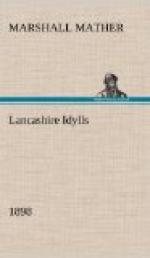’Let him alone, lass; he’s better off nor them as wants fire; there’s no cowd wheer he’s goan.’
Rising from her chair, and turning the sheet once more from off the boy’s face, the mother said:
‘Where hasto goan, lad? Tell thi mother, willn’t taa?’ And then, looking round at the old woman, she said, ’Doesto think he yers (hears) me, Gronny?’
’Aw welly think he does, lass; but durnd bother him naa. He’s happen restin’, poor little lad; or happen he’s telling them as is up aboon all abaat thee—who knows?’
‘Aw say, Gronny, Jesus made deead fo’k yer Him when He spok’, didn’t He?’
‘Yi, lass, He did forsure.’
‘Who wur that lass He spok’ to when He turned ’em all aat o’ th’ room, wi’ their noise and shaatin’?’
‘Tha means th’ rich mon’s lass, doesndto?’
‘Yi! Did He ever do ought for a poor mon’s lass?’
’He did for a poor woman’s lad, thaa knows—a widder’s son—one like thine.’
’But he’s noan here naa, so we’s be like to bide by it, ey, dear? Mi lad! mi lad!’
‘Don’t tak’ on like that, lass; noather on us ’ll hev to bide long. It’s a long road, I know, when fo’k luk for’ards; but it’s soon getten o’er, and when thaa looks back’ards it’s nobbud short. I tell thee I’ve tramped it, and I durnd know as I’m a war woman for the journey. It’s hard wark partin’ wi’ your own; but then theer’s th’ comfort o’ havin’ had ’em. I’d rayther hev a child and bury it, nor be baat childer, like Miriam Heap yonder.’
’Aw dare say as yo’re reet, Gronny; aw’s cry and fret a deal over little Job, but then aw’s hev summat to think abaat, shornd I? Aw geet his likeness taken last Rehoboth fair by a chap as come in a callivan (caravan), and it hengs o’er th’ chimley-piece. But aw’s noan see th’ leet in his een ony more, nor yer his voice, nor tak’ him wi’ me to th’ chapel on Sundos,’ and the woman again turned to the dead boy, and fondly lingered over his familiar features, weeping over them her tears of despair.
‘Come, lass, tha munn’t tak’ on like that. Sit yo’ daan, an’ I’ll tell yo’ what owd Mr. Morell said to me when mi lad lay deead o’ th’ fayver, and noan on ’em would come near me. He said I mut (must) remember as th’ Almeety had nobbud takken th’ lad upstairs. But aw sez, “Mr. Morell, theer’s mony steps, an’ I cornd climb ‘em.” “Yi,” sez he, “theer is mony steps, but yo’ keep climbin’ on ‘em every day, and one day yo’ll ged to th’ top and be i’ th’ same raam (room) wi’ him.” An’, doesto know, every time as I fretted and felt daan, I used to think o’ him as was upstairs, and remember haa aw wur climbin’ th’ steps an’ gettin’ nearer him.’
‘But yo’ve noan getten to th’ top yet, Gronny.’
’No, aw hevn’t, but aw’m a deal nearer nor aw wur when he first laft me. An’ doesto know, lass, aw feel misel to be gettin’ so near naa that aw can welly yer him singin’. There’s nobbud a step or two naa, and then we’s be i’ th’ same raam.’




